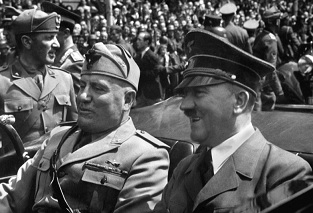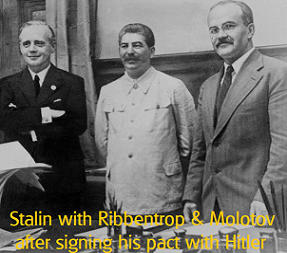![]()
Fascism is as far left as Communism.
Both are socialism’s children.
"Fascist” is one of the most common terms utilized to brand one’s political enemies. This phenomenon has been aggrandized to epic proportions given its immersion in popular culture. While most people or groups who employ it know extraordinarily little about Fascism, they understand all they need to know and it is that it has negative connotations. The term has become atomically weaponized, primarily, by the left to describe, well, basically anyone they do not agree with. However, some on the right, most likely to score politically correct points, have also succumb to the temptation and throw jabs with it every once and a while.
The truth is that its misuse demonstrates the high level of political illiteracy that exists. Some radical left-wing groups, like Antifa, even have it embedded in their name: “antifascism”. Yet, it should surprise no one that just as so few have bothered to read Karl Marx or Friedrich Engels, it is likely that they never even heard of Giovanni Gentile, Fascism’s intellectual overseer. This nescient charade of concept and language manipulation, if consciously confronted, would surprise many. 
Luigi Sturzo, the prominent Italian priest, and sociologist, categorized Fascism “…as black Communism and Communism has red Fascism”. Sturzo, one of the intellectual stewards of the Christian Democratic International and a lifelong antifascist and anticommunist, made a solid connection between Fascism and Communism in simple laymen’s terms. The coupling of what is falsely perceived as being opposites on the ideological spectrum, could not be further from the truth.
Richard Pipes, one of the most learned individuals on Russian history, pointed out that Communism and Fascism were concretely “heresies of socialism” (Pipes 253). The eminent Polish American historian addressed the fact that both systems used totalitarian schemes for organizing society and political power. This point was perhaps made best by Hannah Arendt in the classic The Origins of Totalitarianism (1951). Arendt anatomized the totalitarian prototype, and established the close regime parallels, between Hitler’s Germany and Stalin’s Soviet Union. The German American political scientist and writer pristinely articulated that the common elements in its substantive regime application proved to be congeneric. There was a strong reason for this.
The First International (1864-1876) witnessed a turf war between battling socialist factions. The two principal competing currents were Mikhail Bakunin’s collective anarchism and Marx’s inappropriately labeled “scientific socialism”. Once the dust had settled, it was the Marxist sect that predominated and maintained a hegemonic control over socialism. Big problems began to unfold when Marxism’s “science” began to be disproved.
By the early 20th century, key Marxist components were disintegrating. The predictions which were premised on a “scientific” rendering of historical laws and resting on economic determinism, never took place. Instead of the forecasted increasing misery of the workers and subsequently, of capitalists, salaries and living standards were raised. The proletariat, the expected launching agent of a world Communist revolution, found the capitalist system appealing, workable and its imperfections reformable by way of the intercessions of labor unions and trade associations. In other words, Marxism as it had been sold at the First (1864-1876) and Second International (1889-1916), capitulated morally and epistemologically once the “laws of history” failed to materialize.
This presented a crisis in, what is referred to as, classical Marxism. Its diehard adherents looked for rescue avenues. On the theoretical level, thinkers such as Eduard Bernstein accepted capitalism, believed it could be shifted to the left and formulated an offshoot called social democracy. Other Communists, like Antonio Gramsci and the group referred to as the Frankfurt School, pointed to the failings of the classical variant in its determinant of change: the economic sphere. These founders of what today is alluded to as cultural Marxism or neo-Marxism, put aside the proletariat, handed to the intellectual the task of vanguardism and excused Marx and Engels by proposing that only when culture is hegemonically controlled can social consciousness be raised and sweeping systemic deconstruction commence. Still other Marxist revisionists, like Georges Sorel, distanced himself from the unworkable framework of classical Marxism and embraced a notion of radical revolutionary syndicalism within an organically connected society.
Not all Marxist, however, pondered about the quandary of classical Marxism with intellectual undertakings. Two of these people were Vladimir Lenin and Benito Mussolini. Both were men of revolutionary action. Lenin altered Marxism with his infamous addendum, by inserting a vanguard party to implement a necessary dictatorship of the proletariat and institutionalize democratic centralism, a rigid party discipline mechanism. Mussolini, a trained Marxist whose father befriended Marx in the First International, also grew impatient with the non-occurring laws of history and like Lenin, promoted violent revolution. The French socialist and former Marxist, Sorel, with his insurrectionary syndicalism and the organicism view of society and the state, was the intellectual bridge for Mussolini in his path from Marxism to Fascism. From Lenin, the founder of the first Fascist dictatorship adopted the principle of a revolutionary vanguard party.
 The inclusion of the element of nation into Fascist thought was the work of Italian politician, socialist and founding Italian Fascist Party member, Dino Grandi. As early as 1914, at the onset of World War I, Grandi contended that the Communists had erred and misread the characteristics of the war. For Grandi it was “a class struggle between nations” (Gregor 121). Chinese, Vietnamese, and Cuban Communism offer glaring examples of nationalism fused with Communism. Movements of “national liberation”, have all been typically Communist inspired and nationalist focused.
The inclusion of the element of nation into Fascist thought was the work of Italian politician, socialist and founding Italian Fascist Party member, Dino Grandi. As early as 1914, at the onset of World War I, Grandi contended that the Communists had erred and misread the characteristics of the war. For Grandi it was “a class struggle between nations” (Gregor 121). Chinese, Vietnamese, and Cuban Communism offer glaring examples of nationalism fused with Communism. Movements of “national liberation”, have all been typically Communist inspired and nationalist focused.
A Fascist is a national socialist. The Nazi Party was the National Socialist German Workers’ Party. Joseph Goebbels, Nazi Germany’s Minister of Propaganda, insistently referred to the regime he represented as a superior version of socialism (Mira 125, Peikoff 10). Communist China with its hybrid economy alongside the Marxist-Leninist-Maoist state, bears a great resemblance in praxis to Fascism. It is time to stop the fake labeling. Fascism is as far left as Communism. Both are socialism’s children.
Comments powered by CComment